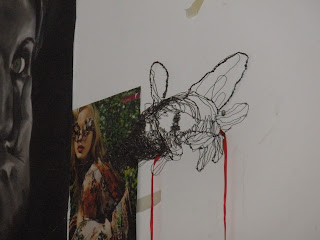"All Grown up, but were still in the playground." - Unknown
Another character combing human and animal form. It started with the drawing (on the left) from my sketchbook. A child with a fox cub's head. Her toy is the city, in the form of a pull along tinker toy.
After the sketch I then went on to do a small painting (below) which I was going to use to make a small story book but I don't think that's going to happen.
"The stars are the street lights of eternity." -Unknown
As I need more 3D In my project I decided to use this character for a 3D piece made out of clay.
The photos below are of the creating process and then the final piece. Unfortunately I did not take a picture of it before the first firing, but you should get the idea. Also as I did this so late, I was unable to do a glaze fire so I had to paint it with acrylics. I think it worked. I left holes in the face and ears so I could use wire to give it whiskers, I also gave him glass beads for eyes.
"You are my plaything, My toy, Your streets are my playground." - Sketchbook notes
 |
| The body is made out of a solid piece of clay. I added plenty of air holes, in case air got rapped and it blew up in the kiln. |
 |
| Making the City toy. |
 |
| The finished Product. Even though I couldn't glaze it I think the acrylic paint worked. |
 |
| Close-up of head. You can see the eyes are glass beads and the whiskers, and the hairs in the ears, and over the eyes are made of wire. |
 |
| Close-up of toy city. |
“I still get wildly enthusiastic about little things... I play with leaves. I skip down the street and run against the wind.”
-Leo F. Buscaglia


















































